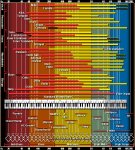Right panning is important (along with EQ, etc). Is panning essentially what you mean by stereo widening, or is there more to it?
My practical (and by no means theoretical) understanding is that applying panning and applying stereo widening create two different perceptual effects and are distinct techniques.
Regarding panning: lets say you have a mono sound (collapsing a stereo sound to mono also usually would work in this example) sitting in the middle of the mix. You could pan it left or right, which would obviously result in it sitting predominantly in either the left or right speakers. Instead, lets say you duplicate it and pan one ALL the way right and one ALL the way left. Because you just duplicated a mono sound and panned it equally to both sides, the resulting sound is the same as the original mono sound. However, if you make slight changes to one of the panned elements versus the others (EQ'ing, reverb, chorus, millisecond delay - search up the Haas effect; these applied to one panned sound but NOT the other) the result is a perceived expanded sound. To explain it non-scientifically, you perceive a sound coming from the left and a slightly different one from the right, but taken together it's perceived as one coherent element, and the "expansion" is the result of the slight differences.
Regarding "stereo wideners": while the above technique does create stereo width, there are plug-ins that will "artificially" widen your stereo instruments. For example, lets say you start with a stereo sound (this could be the one you made using the above technique!) Most stereo wideners that I'm familiar with, namely Ableton Utility and Waves S1, allow you to "widen" the sound (push it away from the listener and to the edges), or allow you to "narrow" the sound (push it toward the listener and near the middle). I'm actually not sure whether this is correct but from my experience this is what stereo wideners as plug-ins do.
So what's the difference between achieving stereo width from using the above panning technique versus "artificial" stereo wideners? Don't quote me on this, but the way I think about it is lets say you have a triangle with a line through the middle so below the line the triangle narrows to the tip and above the line is the fatter part of the triangle and it flattens out on the top. At the tip of the triangle sits the listener, and the triangle represents the space of your mix. Using panning allows your sounds to traverse along the line; if the middle of the triangle is mono, then applying panning, namely the above panning technique, will expand your mix along the line . However, using stereo wideners can push your sounds PAST the line in the fatter, deeper part of the triangle (make elements sound behind and farther out behind your mix) or INSIDE the line in the narrow, closer part of the triangle (make elements sound closer and narrower).
Let me know if that makes sense and if you have any questions!
(And while it's important for your mix to work in mono, lets be honest, what's really important is how it sounds in stereo because almost nobody is listening to it in mono.)


 If you for instance dial in an 1176 at a 4:1 compression ratio at medium attack and max release time, you get the sound very up front, it sounds bigger. If you then combine this with stuff like great monitoring and great M/S processing, then at some point your mix is going to start sounding pretty big...
If you for instance dial in an 1176 at a 4:1 compression ratio at medium attack and max release time, you get the sound very up front, it sounds bigger. If you then combine this with stuff like great monitoring and great M/S processing, then at some point your mix is going to start sounding pretty big...